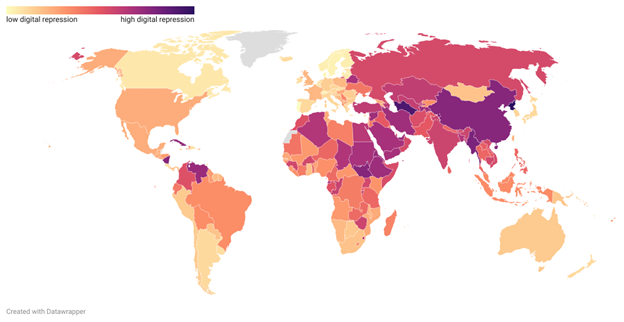Understanding the Incentives Driving Digital Repression

Steven Feldstein provides the first chapter to Global Policy e-book on 'Digital Repression: Causes, Consequences and Policy Responses'. The e-book's chapters will be serialised on Global Policy over the course of 2023. Please find the other chapter's here.
There is a growing recognition that digital technologies can threaten democracy and human rights, empower autocratic regimes, facilitate censorship, and abet surveillance. Yet, researchers and policymakers frequently misunderstand what constitutes digital repression and what factors drive its spread. After laying out constitutive elements of digital repression and describing general trends about digital repression’s relationship to regime type, I will discuss three common inaccuracies related to drivers of technological repression.
Digital repression exhibits a strong relationship with regime type. Regimes that are more authoritarian are more likely to deploy digital repression tools, from mass surveillance and biometrics to online censorship and internet shutdowns (Feldstein 2021). As Figure 1 shows, highly authoritarian countries – such as China, Iran, and North Korea – have elevated levels of digital repression. Conversely, strong liberal democracies, particularly governments in northern Europe, register lower levels of digital repression.

Figure 1. Global prevalence of digital repression in 2021 (Feldstein, Steven. 2022. “Digital Repression Index (updated 2021 data)”. Mendeley Data, V3, doi: 10.17632/5dnfmtgbfs.3)
Digital repression strategies are not uniform; they vary across countries and regime types. Strategies deployed by authoritarian and democratic states differ based on a range of factors: administrative capacity, political norms, resource availability, and regime context. Authoritarian states often rely upon sophisticated digital strategies to control the flow of information and prevent citizens from accessing or publishing content critical of government policies. Experts cite China as a case-study in digital repression. Chinese authorities have established a “great fire wall” that filters content coming in and out of the country, banned foreign internet platforms such as Google and Facebook, and constructed a vast surveillance apparatus combining online monitoring with physical devices (Roberts 2018). China, however, is unique. No other authoritarian regime has attained China’s level of digital repression. In Russia, for example, while there is a growing amount of online censorship and an emerging surveillance apparatus, it still contains permissive elements: YouTube remains accessible to Russian citizens; government officials and ordinary citizens rely on Telegram for communication (Soldatov and Borogan 2022). As Leonid Kovachich and Andrei Kolesnikov (2021) write, “there are vast gaps between the Russian government’s aspirations and its actual ability to harness digital tools such as facial recognition software using artificial intelligence, or China’s nascent social credit system”.
Digital repression tactics are not limited to authoritarian governments; democracies also deploy these tactics. Particularly among weaker democracies, governments frequently use digital repression tools to support their political objectives. In India, for instance, Prime Minister Narendra Modi’s administration has pressed platforms to suppress content that is critical of the government and has authorized police units to raid internet companies that express disagreement with the government’s policies (Iyengar 2023). India also has an “emergent surveillance regime” that includes AI-enabled facial recognition technology and even drones that have been “mainstreamed into public life without statutory basis or the consent of the surveilled” (Mahapatra 2021).
While most people have an intuitive sense of what digital repression encompasses, its underlying causes and possible responses remain debated. Policymakers and experts tend to mischaracterize several aspects in this regard.
First, policymakers often describe digital repression as a problem largely driven by China. They emphasize that the Chinese state is “working to export its high-tech tools and authoritarian principles throughout the globe” (Committee on Foreign Relations 2020) and is advancing an “alternate vision to digital freedom” that is a core part of its strategy to “reshape and lead a new global order” (Special Competitive Studies Project 2022). To be sure, China’s diffusion of digital technology is shaping data governance and leading to negative policy outcomes. China influences global norms through “parallel modeling” – demonstrating the benefits of censorship and surveillance tools and thereby making their use more attractive to other countries (Repnikova 2022). China is attempting to sway the technical standards process in favor of Chinese technologies and infrastructure to reinforce its core foreign policy objectives (Teleanu 2021). The Chinese government also subsidizes advanced technological exports, assuming that countries which build out their technical needs using Chinese equipment are more likely to use Chinese standards and products for future needs (Feldstein 2022a).
Yet on their own, these factors do not render China the primary or exclusive driver of digital repression worldwide. For one, Chinese companies are not the only suppliers of repressive digital tools to autocratic leaders. They face stiff competition from firms based in democracies (in the spyware surveillance sector, for example, companies based in Europe, Israel, and the United States, exhibit far more sales than Chinese firms). There is also scant evidence that China is leveraging the export of repressive technology in pursuit of a grand strategy to establish an alternate governance model (Weiss 2019). In my research, government officials highlighted the low cost of Chinese technology as the most compelling reason to acquire products from Chinese firms (Feldstein 2021).
Second, experts often treat digital technology as an “independent variable” or an “exogenous shock” – relying heavily on supply-side explanations to account for the presence of technological repression (Drezner 2019). Rather than scrutinize political motivations or incentives for why regimes seek intrusive technologies in the first place, experts focus heavily on technological acquisition factors. But overlooking regime dynamics means that analysts are only getting half the picture when it comes to understanding the drivers of digital repression. As Matthew Erie and Thomas Streinz (2021) write, “The digital authoritarianism thesis tends to assume that authoritarians are interchangeable and that China’s data governance approach can be exported”. The reality is more complicated. Many factors determine whether a country will deploy certain digital techniques over others. In Brazil, for instance, there is an established tradition of protecting free expression, meaning that authoritarian censorship strategies – such as filtering content or blocking websites – would face public backlash. In substitute, political parties and politicians (such as former President Jair Bolsonaro) have deployed disinformation strategies. In the run-up to the 2022 election and the subsequent attacks on Brazil’s federal government buildings, disinformation played a prominent role, with false claims about “corruption, Covid, deforestation, and even cannibalism” circulating widely (Horton and Gragnani 2022).
Third, experts place considerable emphasis on export controls as a means to curb digital repression, contending that if democracies stem the supply of digital technologies this will mitigate surveillance or censorship concerns (Polyakova and Meserole 2019). However, it is nearly impossible to stop the diffusion of general use technologies once these innovations have been commercialized. As Audrey Cronin notes in her book Power to the People, at the close of the twentieth century, the United States made a conscious decision to shift from “closed technological development”. where states largely control access to major technological innovations, to “open development”, where innovations are driven by the commercial sector. Devices like smartphones would not exist “without US-government funded programs that created key components, including the microchips, touchscreens, and voice activation systems” (Cronin 2019). But the downside of the open technological revolution is that a wide group of countries – authoritarian and democratic – and even non-governmental actors, can access these same technologies to design repressive systems, whether filtering online content, surveilling private communications and data, or distorting political narratives.
In order for policymakers to come up with practical and effective solutions to counter digital repression, it is essential they have an accurate understanding about its characteristics. The global prevalence of digital repression is not simply a function of Chinese technological exports. Supply-side factors are insufficient to explain why governments choose to acquire digital tools. And stringent export controls on their own will do little to curb the spread of digital repression. Instead, policymakers should look at regime incentives, political interests, and resource capacity to better understand why regimes acquire and deploy repressive technologies.
Steven Feldstein is a senior fellow at the Carnegie Endowment for International Peace in the Democracy, Conflict, and Governance Program. His research focuses on technology and politics, U.S. foreign policy, international relations, and the global context for democracy and human rights. Feldstein is the author of The Rise of Digital Repression: How Technology is Reshaping Power, Politics, and Resistance (2021), which is the recipient of the 2023 Grawemeyer Award for Ideas Improving World Order.
Photo by Amine M'siouri
References
Committee on Foreign Relations, United States Senate. 2020. “The New Big Brother: China and Digital Authoritarianism.” https://www.govinfo.gov/content/pkg/CPRT-116SPRT42356/pdf/CPRT-116SPRT42356.pdf.
Cronin, Audrey Kurth. 2019. Power to the People: How Open Technological Innovation Is Arming Tomorrow's Terrorists. Oxford University Press.
Drezner, Daniel. 2019. “Technological Change and International Relations.” International Relations, 33(2), pp. 286-303.
Feldstein, Steven. 2021. The Rise of Digital Repression How Technology Is Reshaping Power, Politics, and Resistance. Oxford University Press.
Feldstein, Steven. 2022a. “China’s High-Tech Surveillance Drives Oppression of Uyghurs.”
Bulletin of the Atomic Scientists. https://thebulletin.org/2022/10/chinas-high-tech-surveillance-drives-oppression-of-uyghurs/.
Feldstein, Steven. 2022b. “Digital Repression Index (updated 2021 data).” Mendeley Data, V3, doi: 10.17632/5dnfmtgbfs.3
Horton, Jake and Juliana Gragnani. 2022. “Brazil Election: Accusations and Misinformation on the Campaign Trail.” BBC News. https://www.bbc.com/news/63374100.
Iyengar, Rishi. 2023. “Modi is Muzzling Big Tech.” Foreign Policy. https://foreignpolicy.com/2023/01/27/modi-big-tech-india-bbc-documentary-twitter/.
Kovachich, Leonid and Andrei Kolesnikov. 2021. “Digital Authoritarianism with Russian Characteristics?” Carnegie Endowment for International Peace. https://carnegiemoscow.org/2021/04/21/digital-authoritarianism-with-russian-characteristics-pub-84346.
Mahapatra, Sangeeta. 2021. Digital Surveillance and the threat to Civil Liberties in India. German Institute for Global and Area Studies. https://www.giga-hamburg.de/en/publications/giga-focus/digital-surveillance-and-the-threat-to-civil-liberties-in-india.
Ong, Jonathan and Jason Cabañes. 2018. “Architects of Networked Disinformation.” Newton Tech4Dev Network. https://doi.org/10.7275/2cq4-5396.
Polyakova, Alina and Chris Meserole. 2019. “Exporting Digital Authoritarianism. The Russian and Chinese Models.” Brookings. https://www.brookings.edu/wp-content/uploads/2019/08/FP_20190827_digital_authoritarianism_polyakova_meserole.pdf.
Repnikova, Maria. 2022. Chinese Soft Power. Cambridge University Press.
Roberts, Margaret E. 2018. Censored: Distraction and Diversion Inside China's Great Firewall. Princeton University Press.
Soldatov, Andrei and Irinia Borogan. 2022. “The New Iron Curtain.” Center for European Policy Analysis. https://cepa.org/comprehensive-reports/the-new-iron-curtain-2/.
Special Competitive Studies Project. 2022. “Defending Digital Freedom and the Competition for the Future of the Global Order.” https://www.scsp.ai/wp-content/uploads/2022/12/FP-IPR-FOR-RELEASE.pdf.
Teleanu, Sorina. 2021. “The Geopolitics of Digital Standards: China’s Role in Standard-Setting
Organizations.” DiploFoundation. https://www.diplomacy.edu/resource/report-the-geopolitics-of-digital-standards-chinas-role-in-standard-setting-organisations/.
Weiss, Jessica Chen. 2019. “A World Safe for Autocracy? China’s Rise and the Future of Global Politics,” Foreign Affairs 98: 93–94.


